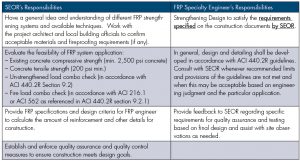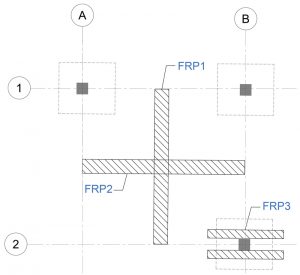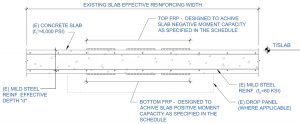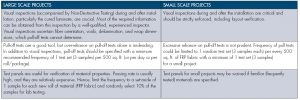Coordination and Quality Control for the Use of FRP Composites
Since its introduction to the commercial construction industry in the 1980s, the use of Fiber Reinforced Polymer (FRP) systems to strengthen/retrofit reinforced concrete and other structures has increased dramatically from a few early experimental projects to currently being the material of choice for many renovation projects. FRP strengthening techniques have gained popularity due to the ease of installation (particularly in occupied spaces), minimal impacts on structural appearance and geometry, cost-effectiveness, and other benefits. The development of codes and standards for externally bonded FRP systems is ongoing in Europe, Japan, Canada, and the United States. For the United States, the publications and standards regarding FRP design procedures for reinforced concrete remain limited to guidelines such as the American Concrete Institute’s ACI 440.2R, Guide for the Design and Construction of Externally Bonded FRP Systems for Strengthening Concrete Structures. These have not been included in the enforceable building codes. This leaves the design and quality assurance processes for FRP strengthening scope up to the consultant teams and local jurisdictions for individual projects.
Design
The detailing of FRP for structural strengthening is a specialization and somewhat dependent on the product selected by the contractor. Therefore, it is typical for the project’s Structural Engineer of Record (SEOR) to delegate the FRP design scope to a third-party engineer working with the product manufacturer and installation contractor to develop the FRP design to meet the project performance criteria. However, even with this delegation of design responsibilities, the overall structural design integrity lies with the SEOR. Hence, they must maintain a sufficient understanding of the externally bonded FRP reinforcement design, various FRP systems available in the market, and their limitations. This knowledge helps the SEOR determine the feasibility of FRP on their project and provide clear information on their documents regarding FRP design performance requirements. That said, the lack of universally adopted standards has led to significant variation in the methods for specifying and denoting FRP strengthening requirements on construction documents.
Certain delegated design items like guardrail systems or building façade and cladding systems are independent of the base building structure, except anchorage, and do not require significant SEOR involvement beyond providing performance criteria and review of loads exerted on the base building structure. On the other hand, delegated design items like structural steel connections and post-tensioned reinforcement become part of the primary structural system by directly affecting the structure’s load-carrying capacity and serviceability. Similarly, as externally bonded FRP strengthening design is a structural reinforcement, it requires significant input and involvement of the SEOR in the design process to ensure a successful project. Recommended responsibilities for the SEOR and FRP specialty engineer for an FRP strengthening project are outlined in Table 1.

As a first step, it is recommended that prior to specifying externally bonded FRP reinforcement as a viable solution for strengthening concrete structures, the SEOR should consider performing a feasibility study including these steps:
a) The structural element to be strengthened shall be analyzed and reviewed for capacity to support minimum new loads without FRP contribution per ACI 440.2R Section 9.2: 1.1 Dead Load + 0.75 Live Load (use 1.0 if sustained Live Load).
b) Structural elements to be strengthened shall be analyzed and reviewed for capacity to support minimum loads considering reduced steel and concrete strength in case of fire event (without FRP contribution) in accordance with ACI 216.1 methodology: 1.0 Dead Load + 1.0 Live Load.
c) Confirm existing concrete compressive strength is higher than 2,500 psi (required minimum for proper bonding of FRP systems). If existing drawings are not available to confirm this information, then testing of core samples is recommended.
d) Check the condition of the existing structure and confirm concrete tensile strength to be a minimum of 200 psi (required minimum for proper bonding of FRP systems). Perform pull-off testing if uncertain.
In addition to this structural feasibility review, it is highly recommended that the SEOR have discussions with the project architect and local jurisdiction building official to confirm acceptance of the use of FRP for the proposed application and any fireproofing requirements that may arise. As previously noted, the incorporation of FRP strengthening into design and building codes is still evolving. Therefore, an early understanding of the local jurisdiction’s stance regarding this strengthening technique is important to avoid permitting and other issues.

After confirmed feasibility, the next task for the SEOR is incorporating FRP strengthening criteria into the bid, permit drawings, and other construction documents. Current methods for communicating these criteria vary significantly. The following is recommended to maximize the FRP specialty engineer’s understanding of design intent and application of FRP:

a) Provide a schematic layout plan depicting areas/elements requiring externally bonded FRP reinforcement with typical details clarifying the design intent to the delegated design engineer (Figure 1 and Figure 2).

b) Provide sufficient information to the delegated design engineer of existing structural properties needed to perform appropriate calculations. A tabulated FRP schedule scheme for FRP reinforcement design requirements, as shown in Table 2, where an example of slab flexural strengthening is shown, is generally recommended to communicate criteria on bid documents. A similar scheme can be applied to other structural strengthening applications. Information that should be provided, when available, includes:
- Concrete compressive strength
- Structural element geometric properties (slab thickness, effective width, etc.)
- Existing reinforcing details, including effective depth and grade of steel
- Design strength requirements (for example, required factored moment capacity and service moments for flexural strengthening)
Construction and Quality Assurances
Similar to other proposed structural systems on a project, the SEOR is also responsible for defining within the structural construction/permit documents the requirements for Special Inspections and Testing for the FRP installation during construction. This can be challenging as codes and standards do not provide details regarding FRP inspection and testing criteria. According to the International Building Code (IBC) Chapter 17, Required Special Inspections and Tests, FRP strengthening would likely be considered “special cases” per Section 1705.1.1, where requirements are dictated by the building official and/or design professional. The lack of detailed standards often leads to an SEOR providing either too little or too superfluous information regarding FRP inspection and testing requirements in their documents. This may result in minimal oversight of the quality of FRP installation.

The ACI 440.2R guideline provides a long list of recommendations regarding a Quality Assurance and Quality Control Program for FRP installation. The guideline recommends that the SEOR becomes familiar with these recommendations and selects a program based on the project type, scale, etc., and ensures the completeness of third-party inspection reports. The following are recommended steps for an FRP inspection and testing program, with a summary provided in Table 3:
- Material Storage Inspection and Product Data Verification, including material testing and sampling.
- On-Site Layout Verification and general observations of existing conditions.
- Surface Preparation Inspection and Concrete Substrate Compressive and Tensile Strength Verification to check if proper surface roughness is provided, cracks are treated per manufacturer requirements, imperfections or obstructions are removed, etc. Consider testing of prepped surface to confirm adequate tensile strength.
- FRP Installation Procedure Observation including saturation of fabric, priming, epoxy application on substrate, and finishing.
- Installed FRP Inspection – cured FRP review for any defects like bubbles, damaged FRP fibers, etc., and recommend repairs at any defective installation locations.
- Final Inspections – Pull tests of installed FRP and inspection of fireproofing (if required).
Conclusions
FRP reinforcement is generally considered a supplementary reinforcement instead of primary reinforcement like mild steel or embedded post-tensioned cables. Hence, strengthening limits enforced by ACI 440 guideline checks ensure that the un-strengthened base structure has sufficient capacity to temporarily support imposed loads without failure in case of vandalism, accidental damage to the FRP reinforcement, or in a fire event until the supplementary reinforcement is repaired/re-installed. However, fireproofing of FRP systems is a complicated discussion topic that is not covered in this article. Fireproofing requirements should be discussed with the local jurisdiction and appropriately provided to meet their requirements.
It is also imperative that, after successful installation of the FRP system, the management and Owner are made aware of the presence of FRP reinforcement and that steps should be taken to ensure that any future additions or modifications do not accidentally damage the FRP reinforcement.
Externally bonded FRP composite systems provide one of the most efficient solutions for strengthening concrete structures. While the commercial construction industry overwhelmingly accepts the use of FRP, it is still a work in progress as far as establishing codes and standards regarding design, inspection, and testing. Following the recommendations provided from feasibility studies, coordination during design and defining inspection/testing criteria will help to ensure a smooth process through each step of an FRP strengthening project.■
